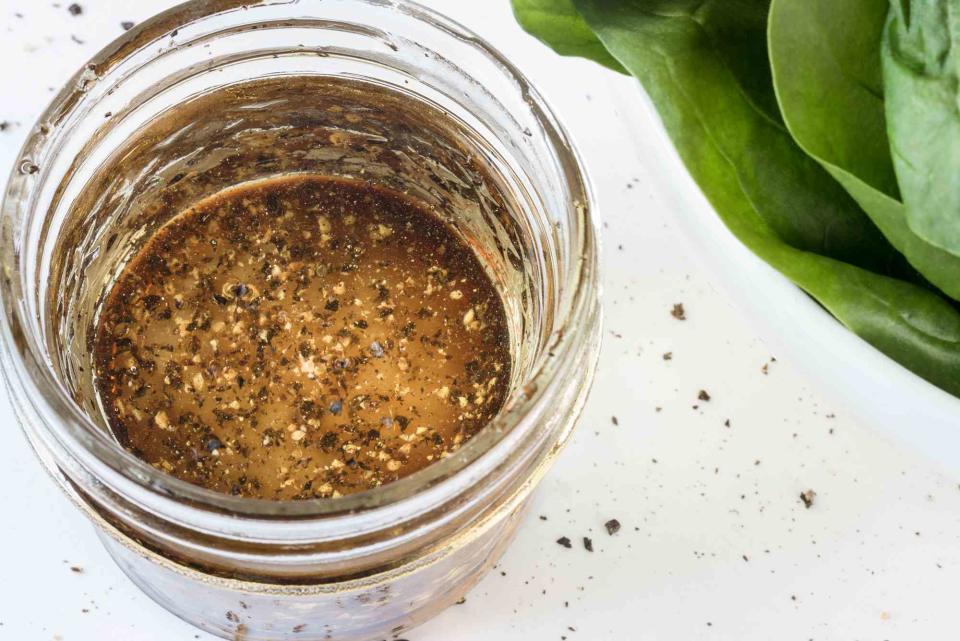The Secret to the Best Vinaigrette Is a Mason Jar
Your sad desk salad deserves this easy upgrade.

Michelle Arnold / Getty Images
My mom almost always has a mason jar of vinaigrette sitting in the refrigerator door. Watching her shake it up before spooning the dressing over side salads to go with our dinner, or being told to add the usual suspects to an empty jar once I’d learned how to make vinaigrette myself were regular parts of my childhood — and when I fly home to Texas now, I can generally count on a jarto be sitting in the fridge. For me, a jar vinaigrette evokes a sense of nostalgia; but that’s not the only reason I love this simple system for making salad dressing. With or without a personal attachment, a jar vinaigrette is the best vinaigrette, because it’s family friendly, easy to prep and store, and no recipe is required.
At its most basic level, making a jar vinaigrette only requires the following: add oil, water, and salt into your container, screw on the lid, and shake vigorously until emulsified. If you’re not familiar with an emulsion in the simplest terms, it’s created when you force two unmixable liquids (like oil and water, or in this case, oil and vinegar) to combine. Shaking your dressing creates tiny bubbles of oil that are suspended in the vinegar, yielding a homogeneous mixture of the two ingredients. Other than the above, there’s no precise formula for a jar vinaigrette. Many cooks recommend doing a ratio of 2:1 oil to vinegar when making salad dressing, and you certainly can, but we’d also recommend trying a 1:1 ratio for a bit more zing. Don’t be afraid to get creative with your vinaigrette! Add whatever feels right to you; options include but are not limited to: pepper, dried herbs, lemon juice, minced shallot, chili flakes, or a touch of honey. Taste as you go, and add more oil and vinegar if you go too far with any one seasoning.
While it’s still optional, let me make a case for adding a little bit of mustard into your vinaigrette as well. Again, this is a choose-your-own-adventure scenario, so if you hate mustard, then live your best mustard-free life! But mustard does act as an emulsifying agent, AKA something that helps two unmixable ingredients combine more easily; consequently, it’ll make shaking up your dressing a little easier, and it’ll keep it from separating out as quickly. My preferred mustard type is Dijon, both for flavor and its ability to emulsify, but almost any mustard will work. A more coarsely-ground mustard likely won’t be as great at keeping your vinaigrette homogenous, but it will still taste delicious.
Related:100 Best Recipes Ever: Salads
When considering what to cook, one of my first thoughts is usually, “How much cleanup will this require?”, a concern that’s amplified by my dishwasher-less Brooklyn kitchen. Whisking a vinaigrette together in a bowl might look fancy, but it means you have to clean both the whisk and bowl, plus, you’ll have to find a container to store the finished dressing in (and a whisk is truly one of the worst things to hand wash).
Herein lies yet another perk of the jarred vinaigrette!
You mix all of the ingredients in one vessel, no whisks required, and you can store the finished product in the jar itself. While it might seem like a silly reason to make a cooking decision, using a jar is also, quite simply, cute. It’s a fun way to get kids involved in the kitchen — they’ll enjoy shaking the vinaigrette up for longer than is necessary — and there’s something satisfying about sliding that homesteader-esque jar of dressing onto your fridge shelf. The jar method is also conducive to meal prep; you can easily make more vinaigrette than you need at once, and store for later use. A vinaigrette without any fresh ingredients (i.e. dairy, shallots, or fresh herbs) will last in your fridge for upwards of two weeks; and one with fresh ingredients will last about a week. Just shake again and you’re ready to dress.
Now that I have my own apartment, you can usually find a jar of vinaigrette in my refrigerator door. It’s easy and useful — especially when packing an office lunch — but it’s also a nice little reminder of where I first learned to cook. There’s something to love about a jar vinaigrette for everyone. If you’re new to cooking, then it’s an excellent lesson in cooking without a recipe and adjusting something according to taste. If you’re an experienced chef, then it’s a simple practice that’s about to make food prep just a little bit easier. No matter what kind of cook you are, I feel confident that you’ll find a jar vinaigrette more useful and satisfying than you expect.

